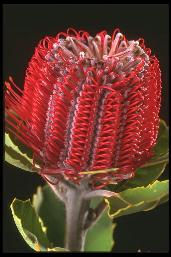October 2000
Did
you know that the most famous Australian flower was not included between the species of
the Olympic Bouquets of the Australian Olympics of the Sydney 2000?
Just
because we think that Banskia represents the beauty of Australian flora more than any
other flower does, we dedicate the link of this month to this particular
flower.
BANKSIA
From the time Joseph Banks collected specimens at Botany
Bay in 1770, Banksias have figured prominently in Australian botany. Their rugged
habit,
dense flower spikes and curious fruit make them a distinctive feature of the
bushland, and
they have been widely cultivated . There are 73 species, of which 58 occur only in
south-western Australia, 14 in eastern Australia and one across tropical Australia and
Papua New Guinea. Popular varieties include coccinea, hookeriana, baxteri
and prionotes. Some are prostrate, some are shrubs and some
trees. The flower
spikes may be large or small, colourful or dull, conspicuous or
hidden; they are various
shades of yellow, orange, red, brown, mauve and green.

Banksia coccinea-Scarlet
Banksia
|
Many have fruit that in form and colour are fascinating in
their own right. Unlike most southern Australian wildflowers the main flush of flowers
comes not in spring but in summer, autumn and winter. For the garden careful selection of
species will ensure that there is always one or more in flower. Most are easily grown from
seed but a few eastern species need stratification. Some can be struck from
cuttings. Most
require well-drained soil in an open position with full sunlight, and fare best without
fertiliser--too much of the last will kill them. Seed extraction can be
difficult; some
species shed the seed as soon as it matures, but in many the fruit needs to be burnt or
heated before the follicles will open.
source:
http://www.feca.org.au/banksia.htm
http://www.agric.wa.gov.au/agency/pubns/
farmnote/1996/f02396.htm
http://farrer.riv.csu.edu.au/ASGAP/banksia.html
|
